Sadik Hafizovic describes how the company he co-founded, Zurich Instruments, has adapted since entering the quantum-computing market

What was your career like before you started Zurich Instruments?
I had always wanted to start a company. Even as a child, I wanted to do stuff bigger than what I could do by myself, stuff that is done by teams. I also liked the idea of running a business and being responsible for the financial side. When I was an undergraduate I financed my studies by running a one-person business providing computer expertise to companies, and that gave me some exposure to different business styles. I saw some companies where the atmosphere was horrible, and others where I thought, wow, it would be cool to build an environment like this.
I came to Switzerland to do my PhD at ETH Zurich, and I worked very closely with Flavio Heer, who is now our chief technology officer. For our PhD research, we developed CMOS-based chips that interfaced with biological neurons. To complement our research, we used lock-in amplifiers to perform impedance spectroscopy on single cells, and we saw things about the instruments that could have been done better. The amplifiers were using digital technology, but they were closely mimicking their analog predecessors: with one instrument, you could work at only one frequency at a time. We wanted eight frequencies simultaneously, so we had to stack up eight instruments. It was awkward, and we knew how with digital signal processing you could put all of that in one box. We defined a task for a student to do as a summer project, which led to a proof-of-principle device, and then another student worked on it for his diploma thesis and brought it to the next level. At that point, I thought, “We can do this.”
How did the company get started?
Initially, Flavio wasn’t sure about the idea of starting a company to make lock-in amplifiers, because although you have to do it right, it’s not “rocket science” like interfacing to neurons. It doesn’t require secret knowhow or patented technology. But our PhDs were coming to an end, and I kept hammering at him, and he was looking for jobs and not finding anything appealing, so at some point he said, “Let’s give it two years.”
We also have a third co-founder, Beat Hofstetter, who comes from a very different background. He went to art school and is a designer by training. He’s also a very good programmer and when he did a diploma thesis at ETH I was one of his supervisors. When he learned that we were starting a company, he immediately wanted to join. Today he is responsible for our entire corporate design.
Who else did you bring in to help you?
None of us had much business experience, and our management experience was limited to leading sub-groups in a university research environment. But the first person we hired, Stephan Koch, was very complimentary in that respect. Stephan has an MBA, and his knowledge of marketing and sales has been indispensable. Hiring him was the best decision ever, and I have to say we were fortunate. We started the company in 2008, the year of the financial crisis, when lots of companies in Zurich were shutting down. Without that, Stephan probably wouldn’t have been looking for a job, and he definitely wouldn’t have been looking for a job at a new company run by three guys just out of school. But he came in and wrote our user manual, fixed our price list, devised an advertising strategy, and worked out which trade shows we should attend. Having that emphasis on marketing really helped us grow, and we would not have achieved that without him.
How did you get funding?
Initially, we thought we needed investors, so we talked to business angels and to a bank, but because we started selling our product so early we decided to do without. I’m happy about that today. We probably could have developed faster if we’d had investors, but we’re growing at 25–30% a year now and I feel this is adequate. I have American friends who tell me I’m wasting my time, that I need to mount a bigger “engine” to grow the company, but I’m happy with it how it is, and so are the people around me.
We were also quite successful in winning business competitions, which gave us about 300,000 Swiss francs (£239,000) in cash, and we had a project with ETH Zurich that was worth another quarter of a million in salaries for people at the university. In addition, we only paid out half of the salaries to the founders. The other half remained in the company as a subordinate loan – meaning that if the company went bankrupt, we would have lost our money.
Finally, it helped that we initially focused on the high end of the market, where the margins are higher and the volume of production is lower. At about the five-year mark we expanded to include the lower end of the market as well, and we also got into neighbouring markets, such as making instruments for quantum computing.
How has the business changed in response to the demands of this new market?
We were already supplying instruments to people who study nuclear magnetic resonance – measuring the spin of hydrogen atoms in water molecules in your body. This is essentially the same as what people in quantum computing do, only they want to measure the spins of single particles, rather than a whole bucket of them. So we developed an instrument specifically for that application, which was new for us.
Before, we were making the equivalent of Swiss army knives, where one instrument is used for many different applications, but for each individual application, it might not be the best conceivable tool. When we started working with the quantum community it was different. We went to visit their labs and worked with them for weeks to fine-tune our tools to suit their very tough requirements. For example, a superconducting qubit in a quantum computer has a lifetime of maybe 100 microseconds, so whatever you want to do to it, you have to do it within 100 microseconds. That means your instruments need to be extremely fast and extremely accurate. If you want to execute quantum gates in, say, 20 nanoseconds, you might have to synchronize 100 channels with 200-picosecond timing. These are tough and very specific requirements that cannot be satisfied with a universal instrument.
Another difference is that requirements in the quantum market change – I don’t want to say on a daily basis, but maybe on a yearly basis. When we entered the field, everyone was telling me, “Hey, Sadik, we need high-electron-mobility transistors in our low-noise amplifiers.” Today, they are asking for travelling-wave parametric amplifiers (TWPAs) – an entirely different technology. We have to compete in an environment where requirements change rapidly, even though developing a new instrument is typically a multi-year project. So we’ve had to become much more agile, and that change has gone through our entire company, from product management to R&D.
The final point I’d like to make, though, is that it’s not enough to just do what customers ask. Researchers typically do not have a broad outlook, because they have a very hard problem that they need to solve now, and they will ask for very pragmatic solutions. But often those are not the best solutions, so you need creative people to come up with the right ones.
How do you find those people?
It’s hard, because there’s a quantum boom going on that absorbs a lot of people. We recently set up a subsidiary in Boston, US, and we have job openings there, but there are no quantum physicists on the market; I read recently that [the US-based electronics and aerospace conglomerate] Honeywell has a hundred people working on ion-trap quantum computing, which is just amazing. However, we are fortunate in the sense that our customers are at university, and at some point, they will be looking for a job. We have hired many happy customers.
What’s been your most difficult challenge?
It’s definitely been on the organization side rather than the technical side. We’ve made mistakes there, usually in relation to company growth and organization development. For example, our first fully fledged subsidiary was in China, and although it’s now a big success story, setting it up was a learning experience for both sides. For example, we got into a situation where people there were talking about “headquarters”, as in, “We have to ask headquarters before we make that decision.” They didn’t feel empowered to take responsibility themselves. And then people in Zurich started talking about “the subsidiary” and I realized, aha, they think that our people in China are working for them.
I’m usually not someone who tells other people how to do their job, but this was a situation where I went in and said, “Nobody says ‘headquarters’ anymore. From now on, we have houses. We have a house in Switzerland, and we have a house in Shanghai, and another house in Boston and more houses in France, Italy and South Korea. We are all Zinians” – that’s what we call employees at Zurich Instruments – “and we are working in different houses, and there is no such thing as ‘headquarters’.” And that’s worked very well. But sometimes you detect these things a bit late.
Any advice for someone thinking of starting a scientific instrumentation company?
Switzerland is the land of the perfectionists, and I’m a naturalized Swiss now, but my advice is that you don’t have to be perfect. I see so many folks grinding and polishing their product, but it doesn’t have to be perfect; it just needs to be better than the competition, and often the competition is not very good. My other advice is that you do need to be your own salesperson. Don’t think that if you make a product, somebody else is going to sell it for you. That was a mistake we made. We thought we would make a product and get distributors to sell it. Very quickly, we understood that distributors are not interested in bringing new brands or instruments to market. We had to do it ourselves.
If you could go back and do anything differently, what would it be?
As the company grew, so did we. Ten years ago, I wouldn’t have been prepared to take on a $10m investment. Today, I think I could. So if I would do it all again, I would take investors on board and build the company faster. But that’s me talking today, and back then I think we made the right choice.
The other thing I’d do differently is to build an even more agile organization. From the outside, we may look like a hardware company, but we have more than 70 employees, and our production team is only four people. We’re actually a software company – that’s where we generate our value, and almost all of our instruments’ functionality is software-defined. So while we do quality control and we manage a production supply chain, the big effort and cost is in software. We go through two software release cycles per year, and I wish it were more. The market for lock-in amplifiers is like icebergs floating past, but in quantum computing it’s a race, and you have to be quick at responding to new requirements. We are now changing the organization towards that, but we could have done it earlier.
When we started in 2008, we wanted to make the best lock-in amplifiers in the world. That was our original vision. But we got there a while ago, and today the vision has changed. Today the vision is, we want to help build a quantum computer. Lock-in amplifiers are important; they’re a pillar of our business, our cash cow, and we are still investing in them. But our new vision is to enable researchers to focus on the physics of the quantum computer and not on the instrumentation.
What is it about quantum computing that attracts you? It sounds like you view it as more than just a business opportunity.
Part of it is that it’s a race. There are many start-ups, and I find that a very stimulating environment. But it’s also the people and the spirit in the community. I find it contagious. People have the attitude of “let’s try it, let’s do it”. Also, the timing is right for us as a business. In three years, the window of opportunity may be gone, and someone else will have become the standard supplier for quantum computing instrumentation. But now we have the opportunity to set global standards, and that’s very appealing.



